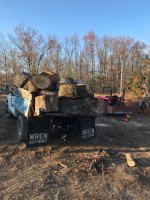motownbrowne
Elite Member
- Joined
- Dec 30, 2013
- Messages
- 2,613
- Location
- river falls, wi
- Tractor
- Kubota mx4700 HST, New Holland TC-29D
I understand barber chairs fairly well on leaning trees.
I guess I should have clarified not exactly a leaner, but a tree that's hung up in another tree as it falls. So the tree starts to go, and for whatever reason (poor planning, odd twist, misjudgment of mass, pilot error, etc...) the tree falls into another tree and hangs mid-fall. What do you do?
I've had it happen twice in the last 6 years. What I did is probably dangerous, so I'd like a better solution. I ended up cutting a new notch on the top side of the tree, and doing a back cut from the underside, stopping to put a wedge in, then continuing. Basically, I'm felling the tree away from the lean. What happens is the tree buckles towards the hang, snaps the hinge, and drops straight down into the dirt. That decreases the angle of lean, but the tree is now 16" shorter and still hung. I've had to repeat this 5-6 times until the tree ends up vertical in the hang. The last cut section makes it fall away from the hang and down it goes.
Anyhow, this sounds awfully unsafe. However, I have no way to pull the tree bottom away from the lean and drag the tree out the way it probably should be done. I don't think a come along would be strong enough. I don't want to fell the tree that its hanging in, as I'd then have two trees to contend with.
On a couple occasions, I've been able to notch the tree that its hung in, then drop a 3rd tree on that to force it to fall.
Anyhow, other than bringing in a heavy piece of equipment, a winch, or god forbid, just plan better in the first place, what do other folks do that is acceptably safe? Is the only safe alternative a long cable and winch well away from the tree?
Another good option, and something I've taken to doing even felling bigger trees in my dense mature hardwood stand is to set a rope (or wire rope) up high before making any cuts. So far I've just used an extension ladder to put a choker about 25' off the ground, but I'm planning on buying a 5/8" bull rope and a throw line setup. With a throw bag it's pretty easy to put a line well up into a tree using a running bowline knot. The higher you get your line the less pulling power you need. Also, you can add a doubling block if need be. I bet a rope set high like that would allow a small tractor like yours to really help manage a stuck tree from a comfortable distance.

